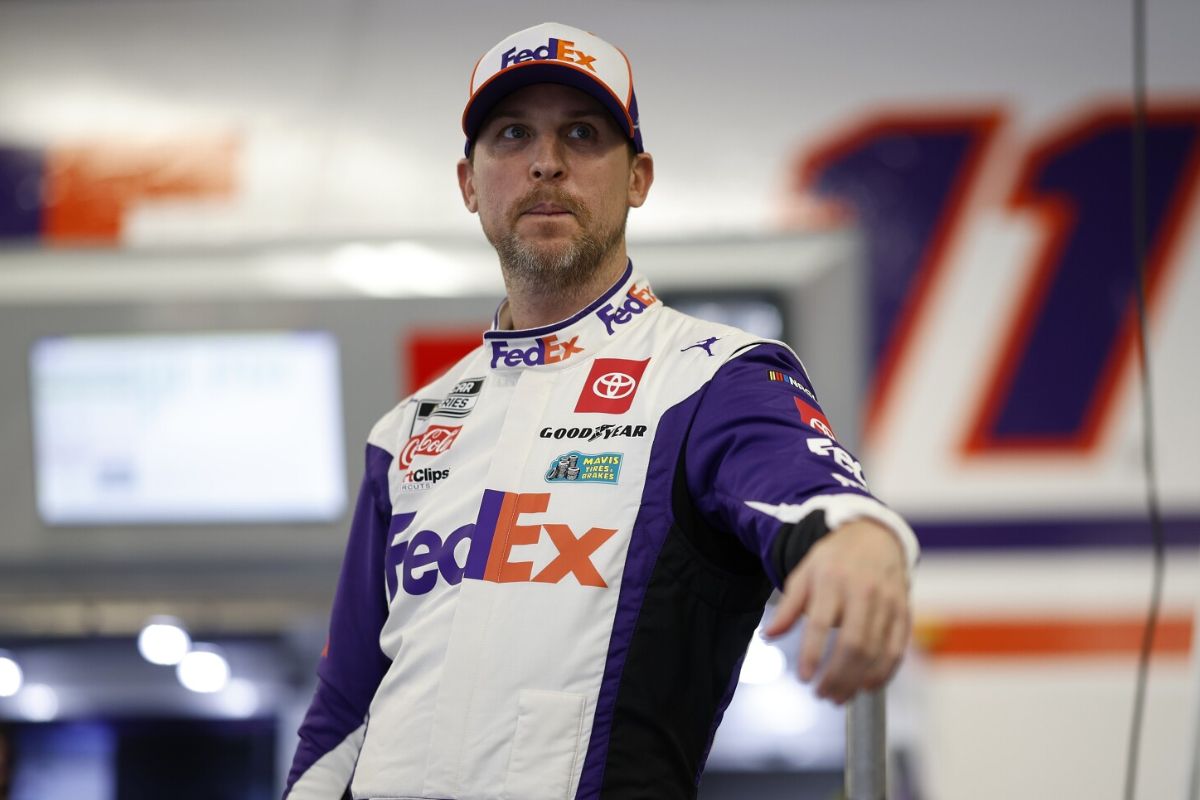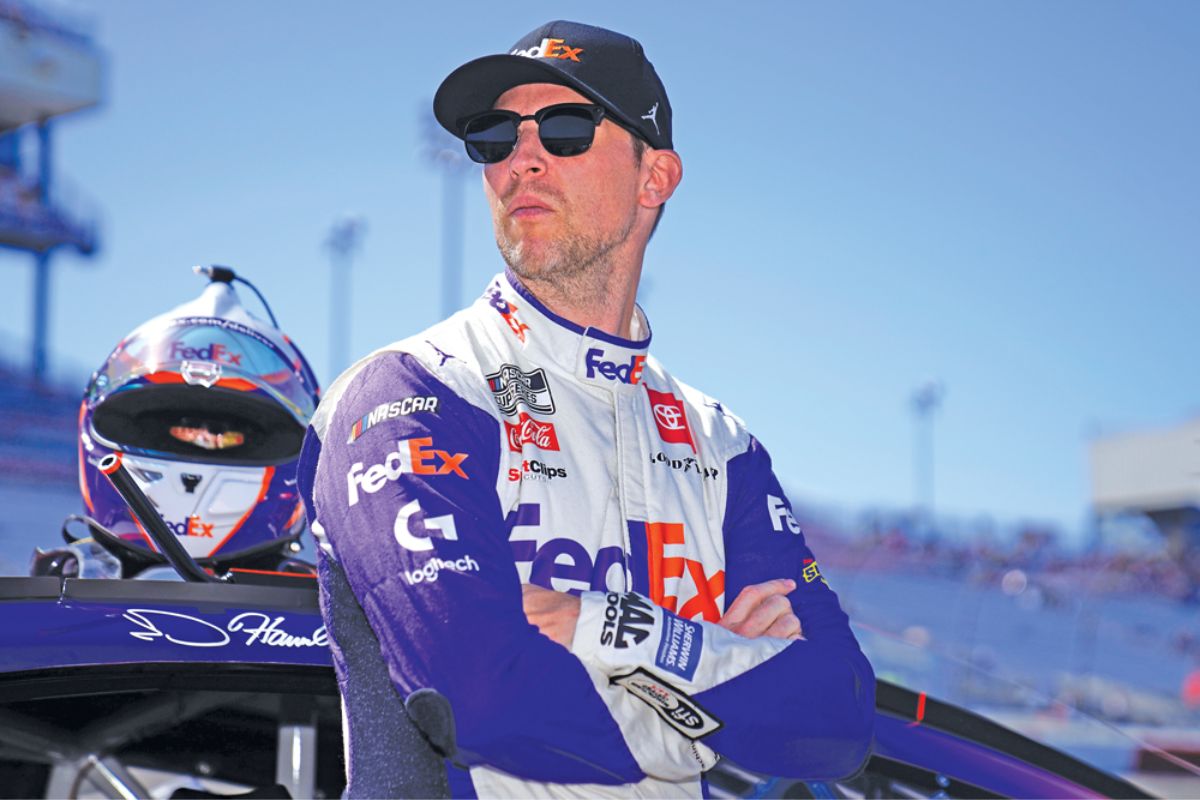Denny Hamlin’s Bold Statement: In a striking declaration, Denny Hamlin posits that the legendary Earnhardt era at Talladega may have reached its culmination, a perspective that not only challenges the sentiments of NASCAR fans but also underscores a critical transformation within the sport. This claim comes amidst the advent of the Next Gen car, which profoundly alters the dynamics of superspeedway racing.
Key Takeaways
- Denny Hamlin suggests the racing dynamics at Talladega have changed with the introduction of the Next Gen car.
- The new car design promotes uniform performance, altering traditional race strategies.
- Hamlin’s statement implies a shift from the aggressive, high-risk racing associated with Earnhardt’s era.
- Concerns center on the impact of these changes on the spectator experience and the essence of NASCAR.
- Hamlin calls for preserving NASCAR traditions while adapting to technological innovations.
Denny Hamlin’s Concerns Over Talladega Racing
As a seasoned NASCAR driver with significant experience on such tracks, Hamlin’s perspective carries weight in the racing community. His view points to a pivotal shift in racing dynamics, specifically at superspeedways like Talladega, which have historically been theatres of the dramatic, unpredictable, and often awe-inspiring maneuvers reminiscent of racing legends like Dale Earnhardt.
Hamlin’s concerns are around the evolving nature of car technology and race strategy, which, according to him, have altered the fundamental aspects of superspeedway competitions. His reference to the end of an era — the kind in which a driver such as Earnhardt could artfully navigate from midfield to victory — marks a old yet critical view of current trends in NASCAR. This perspective is not just about the thrill or the spectacle but touches on deeper elements like competitive integrity and the essence of driver skill in modern racing.

Next Gen Car Alters Superspeedway Racing Dynamics
As the Next Gen car is introduced into NASCAR, it profoundly alters the dynamics of superspeedway racing, challenging the traditional strategies that once enabled drivers like Dale Earnhardt to dominate. The new vehicle design promotes a more uniform performance among cars, greatly reducing the gaps that previously allowed for standout leaders. This shift necessitates a new approach to racing, emphasizing strategic pack formation and the management of track position over the aggressive, solitary breakaways characteristic of past eras.
The aerodynamic properties of the Next Gen car, combined with its advanced engineering, create a level playing field that requires closer, more calculated driving. This is a marked departure from the historical superspeedway races where experienced drivers could exploit specific car capabilities to forge significant leads. Now, drivers find themselves in denser packs where the slipstream and drafting become essential to maintaining or advancing position. This pack mentality diminishes the opportunity for a single driver to dominate a race from start to finish as Earnhardt once did.
“For the fans’ sake, I hope it’s not a lot. But we’ll probably have some, just simply because that’s the nature of the game. You want to have the smallest pitstops possible because it is such a track position race. The days of Dale Earnhardt going from wherever to the front just isn’t possible with the way that we draft in the Next Gen cars”-Hamlin
Moreover, Denny Hamlin’s observations show a broader sentiment within the NASCAR community that these changes, while enhancing safety and competitiveness, may divert from the spectator thrill associated with unpredictable, lead-changing dynamics. The new format encourages a more tactical, restrained style of racing, where the focus shifts from individual daring to collective strategy and execution.
“It’s all about track position and we’re just doing everything we can to have that pitstop as short as possible we found that not running 100% through the entire race helps us do that, so not until that last pitstop will you see us kind of going all out”-Hamlin
Talladega Expectations: A Slow Burn
Denny Hamlin anticipates a markedly cautious racing strategy at Talladega, where maintaining prime track position will be crucial for success. This adjustment in tactic reflects a shift from the overtly aggressive maneuvers that once defined races at this iconic superspeedway. Instead, teams are now channeling their efforts into strategic positioning, aiming to minimize pit stops and preserve their place within the pack for as long as possible. This approach shows a broader evolution in racing.
The implications of this strategic pivot are profound. By prioritizing track position over aggressive overtaking, drivers are effectively recalibrating the race dynamics at Talladega. This not only alters the viewer experience—shifting from a spectacle of constant lead changes to a more nuanced, chess-like contest—but also impacts the drivers’ approach to each lap.
Moreover, Hamlin’s acknowledgment of the limited scope for dramatic comebacks underlines a significant transformation in racecraft. In previous eras, a driver could hope to surge from the back of the pack to secure victory in a breathtaking finish. Today, however, such feats are increasingly difficult, given the tactical emphasis on maintaining an advantageous position throughout the race rather than risking all on gambles.

Concerns Over Scoring Pylon Removal
The removal of scoring pylons at NASCAR tracks, including Talladega, raises significant concerns about the impact on spectator engagement and track tradition. These iconic structures have not only served as a functional tool for displaying race standings but also as a symbol of race-day excitement and history. Denny Hamlin’s point toward a deeper issue: the balance between modernization and maintaining the perfect race-day atmosphere that fans cherish.
NASCAR officials argue that the pylons are outdated and occupy valuable space that could be better utilized. This perspective prioritizes logistical efficiencies and perhaps, the potential for new technologies that could enrich the fan experience in different ways. However, this change must be handled with sensitivity to fan expectations and historical significance. The challenge lies in ensuring that any new features introduced in place of the pylons are not only technologically advanced but also enrich the race-watching experience in a manner that respects the tradition.
For many, the pylon is not just a structure but a part of the collective memory of races witnessed and shared. This change could potentially alienate longstanding fans who view such elements as integral to the NASCAR spectacle. Engagement strategies moving forward should consider these aspects deeply. NASCAR needs to find a way to innovate without losing the essence of what makes attending a race special.
Hamlin’s Call to Preserve Tradition
Reflecting on the broader implications of NASCAR’s modernization efforts, Hamlin’s advocacy for the preservation of scoring pylons underscores a fundamental debate about the conservation of racing traditions. As NASCAR evolves, integrating more technology and modern elements into its operations, the question arises about what should remain sacrosanct. Hamlin’s perspective shows this discourse, emphasizing not just the functionality of such traditions, but their role in enriching the fan experience and connecting generations of racing enthusiasts.
Scoring pylons, as noted by Hamlin, serve more than the practical purpose of displaying race standings; they are iconic symbols of the NASCAR spectacle, imbued with nostalgia and reverence from fans and drivers alike. Their presence at tracks is a nod to the sport’s rich history, a tangible link to the past amid the rapidly changing landscape of auto racing.
“Every time I go through a tunnel, and it might be just me, the first thing I do is look at the scoring pylon and see who’s where, so maybe it’s more of a sentimental thing from a purist like myself….I think it started with Bristol, taking some out, and then it was Watkins Glen that I noticed, and obviously, last week and then now this week, so hopefully it’s not a trend.”-Hamlin

News in Brief: Denny Hamlin’s Bold Statement
Denny Hamlin’s views regarding the decline of the Earnhardt era at Talladega shows a transformation within NASCAR, led by technological advancements in the Next Gen car. This evolution in vehicle dynamics is reshaping strategies and expectations at superspeedways, challenging traditional racing model.
Hamlin’s call for the preservation of tradition amidst these changes highlights a critical tension between innovation and historical continuity, central to the future discussion in NASCAR’s competitive landscape.
Our Reader’s Queries
Q: What did Denny Hamlin say on social media?
A: Hamlin’s post on X, “When paving on a budget goes wrong. (North Wilkesboro) will be next,” sparked controversy. Smith retorted, “This is a great post from somebody who doesn’t know all the information. Ignorance on display for the world to see!”
Q: What is Denny Hamlin’s real name?
A: Meet James Dennis Alan Hamlin, a force in NASCAR, driving the No. 11 Toyota Camry XSE for Joe Gibbs Racing.
Q: What did Denny Hamlin place?
A: Denny Hamlin’s recent NASCAR Cup Series results:
- 4/14: Texas – 30th place
- 4/7: Martinsville – 11th place
- 3/31: Richmond – 1st place
Also Read: Denny Hamlin Defies NASCAR’s Defense – ‘Pylon Was Personal’ at Talladega
